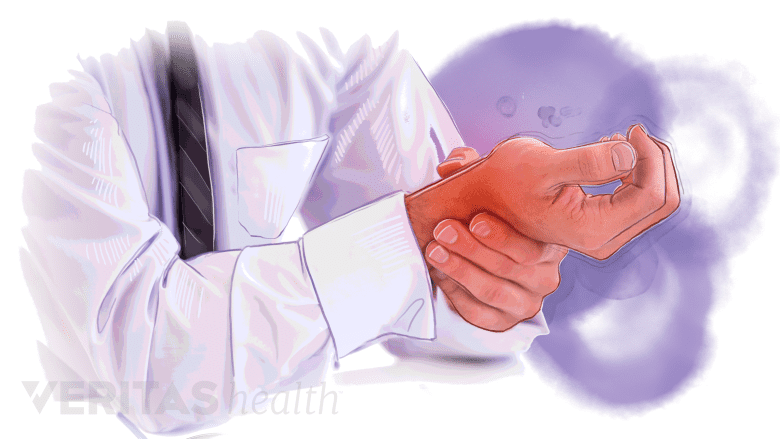Most people have experienced hand pain, such as from a bump, overuse, or temporary exposure to an extreme temperature (hot or cold). If hand pain persists or is accompanied by tingling, numbness, or weakness, an underlying medical condition might exist.
In This Article:
- Understanding Hand Pain and Numbness
- What Causes Hand Pain and Numbness?
- Video: What is Causing my Hand Pain and Numbness?
- Cervical Radiculopathy Interactive Video
What Does Hand Pain and Numbness Feel Like?
Hand pain and/or numbness can develop gradually or develop after an injury.
Hand pain and/or numbness may develop slowly or appear following an injury, such as a bike accident. It is more likely to occur in one hand but may be in both. Many people with hand pain and/or numbness report one or more of the following:
- Persistent aching pain in one or more fingers, which could also go into the wrist or arm
- Numbness, tingling, or other altered sensations in the hand, which could also include feelings of being itchy, icy, or warm
- Sharp or shock-like pain that flares occasionally or becomes constant, possibly felt in the shoulder and/or arm in addition to the hand
- Decreased hand mobility or coordination to perform important daily tasks, such as buttoning a shirt or typing on a keyboard
- Weakness that reduces the ability to grip objects, such as a glass, or carry items, such as a box
- Increased incidence of scrapes or burns due to not being able to feel or sense danger along parts of the skin
Hand pain and/or numbness may worsen during certain movements or activities, such as:
- Hand overuse or repetitive motions, such as typing or knitting
- Vigorous activities, such as playing sports or lifting weights
- Sleeping with the hand, arm, or neck in an awkward position
See Carpal Tunnel Syndrome vs. Cervical Radiculopathy
Some people with both hand pain and numbness might experience more numbness than pain, whereas others might have more pain.
Nerve Anatomy Involved in Hand Pain and Numbness
Nerves that run from the neck to the hand may be involved in causing hand pain and numbness.
The hand and fingers are controlled by a network of nerves that stem all the way from the neck. Starting in the cervical spine, nerve roots C5 to C8 and T1 branch off from the spinal cord and feed into nerves going down into the shoulder, arm, and various parts of the hand and fingers (depending on the specific nerve root involved).
See All About the C5-C6 Spinal Motion Segment
See All About the C6-C7 Spinal Motion Segment
See All About the C7-T1 Spinal Segment (Cervicothoracic Junction)
The three main nerves traveling through the wrist and into the hand are:1Neal SL, Fields KB. Peripheral nerve entrapment and injury in the upper extremity. Am Fam Physician. 2010; 81(2):147-55.
- Median nerve, which provides sensation for the palm and goes into the thumb, index finger, middle finger, and part of the ring finger
- Ulnar nerve, which provides sensation in the outer edge of the hand and goes into the ring and pinky fingers
- Radial nerve, which provides much of the sensation for the back of the hand and goes into the thumb and first two fingers
Read Ligaments, Tendons, and Nerves of the Wrist on Sports-health.com
Any type of problem that affects a nerve or branch of nerves anywhere from the neck down into the hand may play a role in hand pain and numbness. Less commonly, a problem in the brain or spinal cord is the cause.
Development of Hand Pain and Numbness
Compression of cervical nerves can result in pain and numbness in the hand.
Hand pain and numbness may develop due to:
- Nerve compression or irritation, such as in the neck, arm, or hand
- Nutritional deficiency or side effect of medication
- Various diseases, such as diabetes
See What Is Cervical Radiculopathy?
Other rare causes are also possible. Sometimes multiple factors can cause hand pain and numbness to occur together.
Getting a Diagnosis for Hand Pain and Numbness
There are many possible causes of hand pain and numbness. A physiatrist, orthopedic surgeon, or other medical doctor can diagnose the underlying cause of hand pain and numbness. Getting an accurate diagnosis is important to setting up a safe and effective treatment plan.
- 1 Neal SL, Fields KB. Peripheral nerve entrapment and injury in the upper extremity. Am Fam Physician. 2010; 81(2):147-55.








